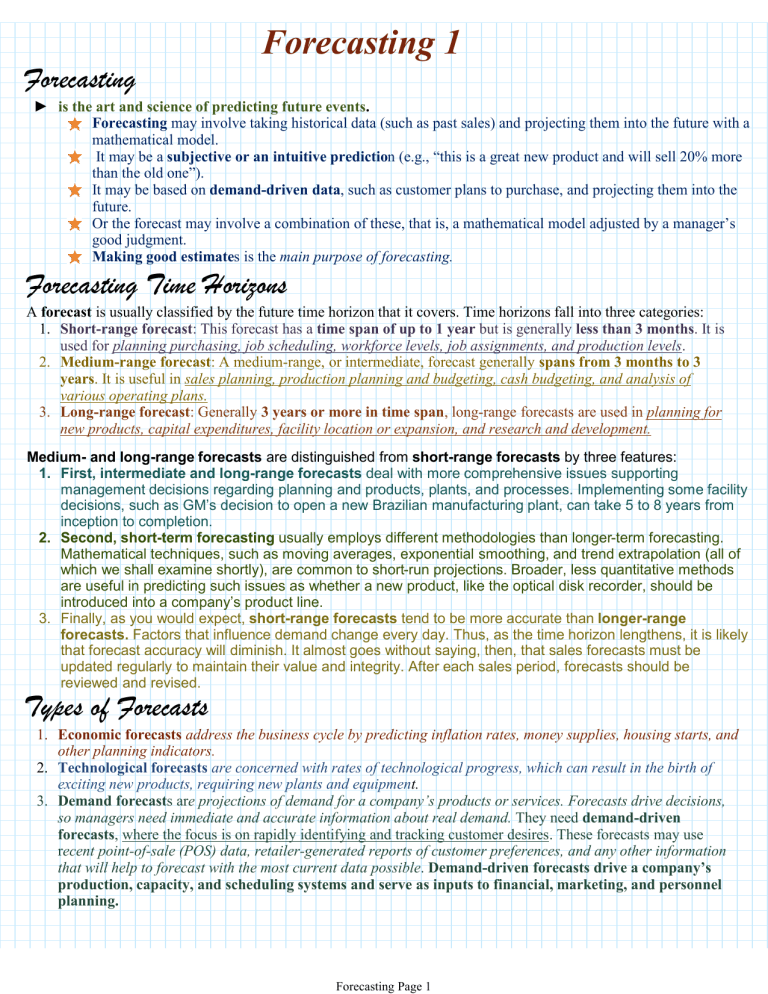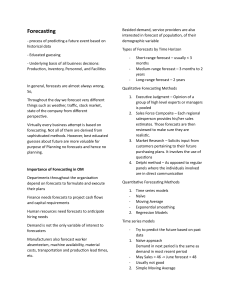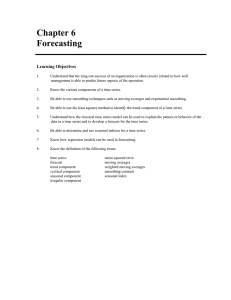
Forecasting Forecasting 1 ► is the art and science of predicting future events. Forecasting may involve taking historical data (such as past sales) and projecting them into the future with a mathematical model. It may be a subjective or an intuitive prediction (e.g., “this is a great new product and will sell 20% more than the old one”). It may be based on demand-driven data, such as customer plans to purchase, and projecting them into the future. Or the forecast may involve a combination of these, that is, a mathematical model adjusted by a manager’s good judgment. Making good estimates is the main purpose of forecasting. Forecasting Time Horizons A forecast is usually classified by the future time horizon that it covers. Time horizons fall into three categories: 1. Short-range forecast: This forecast has a time span of up to 1 year but is generally less than 3 months. It is used for planning purchasing, job scheduling, workforce levels, job assignments, and production levels. 2. Medium-range forecast: A medium-range, or intermediate, forecast generally spans from 3 months to 3 years. It is useful in sales planning, production planning and budgeting, cash budgeting, and analysis of various operating plans. 3. Long-range forecast: Generally 3 years or more in time span, long-range forecasts are used in planning for new products, capital expenditures, facility location or expansion, and research and development. Medium- and long-range forecasts are distinguished from short-range forecasts by three features: 1. First, intermediate and long-range forecasts deal with more comprehensive issues supporting management decisions regarding planning and products, plants, and processes. Implementing some facility decisions, such as GM’s decision to open a new Brazilian manufacturing plant, can take 5 to 8 years from inception to completion. 2. Second, short-term forecasting usually employs different methodologies than longer-term forecasting. Mathematical techniques, such as moving averages, exponential smoothing, and trend extrapolation (all of which we shall examine shortly), are common to short-run projections. Broader, less quantitative methods are useful in predicting such issues as whether a new product, like the optical disk recorder, should be introduced into a company’s product line. 3. Finally, as you would expect, short-range forecasts tend to be more accurate than longer-range forecasts. Factors that influence demand change every day. Thus, as the time horizon lengthens, it is likely that forecast accuracy will diminish. It almost goes without saying, then, that sales forecasts must be updated regularly to maintain their value and integrity. After each sales period, forecasts should be reviewed and revised. Types of Forecasts 1. Economic forecasts address the business cycle by predicting inflation rates, money supplies, housing starts, and other planning indicators. 2. Technological forecasts are concerned with rates of technological progress, which can result in the birth of exciting new products, requiring new plants and equipment. 3. Demand forecasts are projections of demand for a company’s products or services. Forecasts drive decisions, so managers need immediate and accurate information about real demand. They need demand-driven forecasts, where the focus is on rapidly identifying and tracking customer desires. These forecasts may use recent point-of-sale (POS) data, retailer-generated reports of customer preferences, and any other information that will help to forecast with the most current data possible. Demand-driven forecasts drive a company’s production, capacity, and scheduling systems and serve as inputs to financial, marketing, and personnel planning. Forecasting Page 1 Forecasting 2 Forecasting Approaches Quantitative forecasts use a variety of mathematical models that rely on historical data and/or associative variables to forecast demand. Subjective or qualitative forecasts incorporate such factors as the decision maker’s intuition, emotions, personal experiences, and value system in reaching a forecast. Qualitative Methods ► The jury of executive opinion: Under this method, the opinions of a group of high-level experts or managers, often in combination with statistical models, are pooled to arrive at a group estimate of demand. Bristol-Myers Squibb Company, for example, uses 220 well-known research scientists as its jury of executive opinion to get a grasp on future trends in the world of medical research. ► Delphi method: There are three different types of participants in the Delphi method: decision-makers, staff personnel, and respondents. Decision makers usually consist of a group of 5 to 10 experts who will be making the actual forecast. The state of Alaska, for example, has used the Delphi method to develop its long-range economic forecast. A large part of the state’s budget is derived from the million-plus barrels of oil pumped daily through a pipeline at Prudhoe Bay. The large Delphi panel of experts had to represent all groups and opinions in the state and all geographic areas. ► Sales force composite: In this approach, each salesperson estimates what sales will be in his or her region. ► Market survey: This method solicits input from customers or potential customers regarding future purchasing plans. It can help not only in preparing a forecast but also in improving product design and planning for new products. Quantitative Methods. ► Time-series models predict on the assumption that the future is a function of the past. In other words, they look at what has happened over a period of time and use a series of past data to make a forecast. ► Associative models, such as linear regression, incorporate the variables or factors that might influence the quantity being forecast. Time-Series Forecasting Time series is based on a sequence of evenly spaced (weekly, monthly, quarterly, and so on) data points. Examples include weekly sales of Nike Air Jordans, quarterly earnings reports of Microsoft stock, daily shipments of Coors beer, and annual consumer price indices. Decomposition of a Time Series 1. Trend is the gradual upward or downward movement of the data over time. Changes in income, population, age distribution, or cultural views may account for movement in trend. 2. Seasonality is a data pattern that repeats itself after a period of days, weeks, months, or quarters. 3. Cycles are patterns in the data that occur every several years. They are usually tied into the business cycle and are of major importance in short-term business analysis and planning. 4. Random variations are “blips” in the data caused by chance and unusual situations. They follow no discernible pattern, so they cannot be predicted Naïve Method The simplest way to forecast is to assume that demand in the next period will be equal to demand in the most recent period. In other words, if sales of a product—say, Nokia cell phones—were 68 units in January, we can forecast that February’s sales will also be 68 phones. The naive approach is the most cost-effective and efficient objective forecasting. Forecasting Page 2 Forecasting 3 Moving Averages ► Forecast uses a number of historical actual data values to generate a forecast. Moving averages are useful if we can assume that market demands will stay fairly steady over time. Mathematically, the simple moving average (which serves as an estimate of the next period’s demand) is expressed as: where n is the number of periods in the moving average—for example, 4, 5, or 6 months, respectively, for a 4-, 5-, or 6-period moving average. Weighted Moving Averages ► Weights can be used to place more emphasis on recent values. This practice makes forecasting techniques more responsive to changes because more recent periods may be more heavily weighted. Both simple and weighted moving averages are effective in smoothing out sudden fluctuations in the demand pattern to provide stable estimates. Moving averages do, however, present three problems: 1. Increasing the size of n (the number of periods averaged) does smooth out fluctuations better, but it makes the method less sensitive to changes in the data. 2. Moving averages cannot pick up trends very well. Because they are averages, they will always stay within past levels and will not predict changes to either higher or lower levels. That is, they lag the actual values. 3. Moving averages require extensive records of past data. Forecasting Page 3 Forecasting 4 Exponential Smoothing ► Exponential smoothing is another weighted-moving-average forecasting method. It involves very little recordkeeping of past data and is fairly easy to use. The basic exponential smoothing formula can be shown as follows: where a is a weight, or smoothing constant, chosen by the forecaster, that has a value greater than or equal to 0 and less than or equal to 1. Equations (4-3) can also be written mathematically as: The smoothing constant, a, is generally in the range of .05 to .50 for business applications. It can be changed to give more weight to recent data (when a is high) or more weight to past data (when a is low). Selecting the Smoothing Constant: The following table helps illustrate this concept. For example, when a = .5, we can see that the new forecast is based almost entirely on demand in the last three or four periods. When a = .1, the forecast places little weight on recent demand and takes many periods (about 19) of historical values into account. Exponential smoothing has been successfully applied in virtually every type of business. However, the appropriate value of the smoothing constant, a, can make the difference between an accurate forecast and an inaccurate forecast. High values of a are chosen when the underlying average is likely to change. Low values of a are used when the underlying average is fairly stable. In picking a value for the smoothing constant, the objective is to obtain the most accurate forecast. Measuring Forecast Error The overall accuracy of any forecasting model—moving average, exponential smoothing, or other—can be determined by comparing the forecasted values with the actual or observed values. If Ft denotes the forecast in period t, and At denotes the actual demand in period t, the forecast error (or deviation) is defined as: Forecasting Page 4 Forecasting 5 Mean Absolute Deviation: The first measure of the overall forecast error for a model is the mean absolute deviation (MAD). This value is computed by taking the sum of the absolute values of the individual forecast errors (deviations) and dividing by the number of periods of data (n). Mean Squared Error: The mean squared error (MSE) is a second way of measuring overall forecast error. MSE is the average of the squared differences between the forecasted and observed values. Mean Absolute Percent Error: A problem with both the MAD and MSE is that their values depend on the magnitude of the item being forecast. If the forecast item is measured in thousands, the MAD and MSE values can be very large. To avoid this problem, we can use the mean absolute percent error (MAPE). This is computed as the average of the absolute difference between the forecasted and actual values, expressed as a percentage of the actual values. Forecasting Page 5 Forecasting 6 Trend Projections ► This technique fits a trend line to a series of historical data points and then projects the slope of the line into the future for medium- to long-range forecasts. ► Least-squares method: This approach results in a straight line that minimizes the sum of the squares of the vertical differences or deviations from the line to each of the actual observations. A least-squares line is described in terms of its y-intercept (the height at which it intercepts the y-axis) and its expected change (slope). If we can compute the y-intercept and slope, we can express the line with the following equation: Notes on the Use of the Least-Squares Method Using the least-squares method implies that we have met three requirements: 1. We always plot the data because least-squares data assume a linear relationship. If a curve appears to be present, curvilinear analysis is probably needed. 2. We do not predict time periods far beyond our given database. For example, if we have 20 months’ worth of average prices of Microsoft stock, we can forecast only 3 or 4 months into the future. Forecasts beyond that have little statistical validity. Thus, you cannot take 5 years’ worth of sales data and project 10 years into the future. The world is too uncertain. 3. Deviations around the least-squares line (see Figure 4.4) are assumed to be random and normally distributed, with most observations close to the line and only a smaller number farther out. Forecasting Page 6






